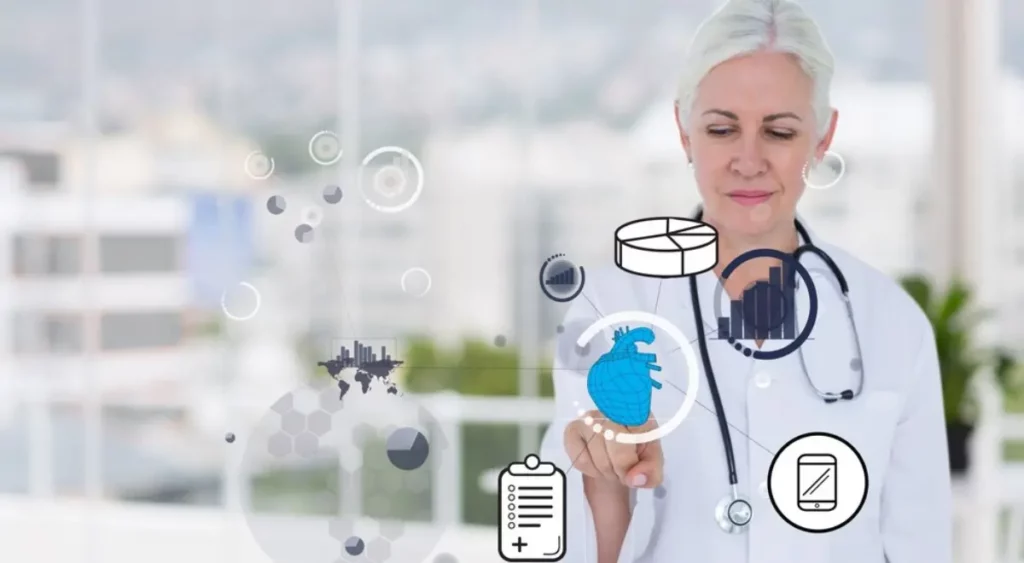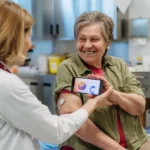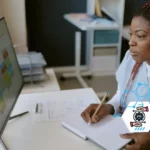Remote Care Programs Covered By HealthArc’s Digital Health Platform

With the emergence of AI technology and digital health platforms, healthcare is gradually shifting beyond the four walls of the hospital, making in-home or remote care convenient and accessible. There has been tremendous progress in the adoption of digital health technologies and remote care programs such as Remote Patient Monitoring (RPM), Remote Therapeutic Monitoring (RTM), Chronic Care Management (CCM), Transitional Care Management (TCM), and Principal Care Management (PCM) are becoming more accessible for chronically ill patients.
Table of Contents
ToggleTypes Of Remote Care Programs Supported By HealthArc
Healthcare organizations and providers are implementing various remote care programs to improve clinical processes, efficiency, and overall patient care. But, with so many different programs available for providers, choosing the best one for the patients may seem daunting.
To help make the right choice, it’s important to understand the various remote care programs comprehensively, ranging from their implementation to billing, and diagnostic criteria to patient care.
HealthArc’s all-in-one digital healthcare platform helps practices connect to their patients, optimize reimbursement and minimize documentation with increased clinical efficiency. Our HIPAA compliant software ensures you are adhering to the policies and organized for accurate billing. Our platform supports:
- Remote Patient Monitoring (RPM)
RPM uses digital remote monitoring devices to monitor and collect physiological health data from patients outside of the clinic, such as blood pressure, blood sugar, weight, and oxygen levels. These cellular or Wi-Fi devices securely transfer that data straight to healthcare providers, who monitor a patient’s vital signs in between clinical visits. RPM must be administered by a physician or qualified health care provider (QHCP) who is authorized to bill for emergency medical services.
To generate reimbursements it is medically recommended to use FDA-approved monitoring devices, a minimum requirement of 16 days of readings per 30 days, and require clinical staff to spend at least 20 minutes per month.
- Remote Therapeutic Monitoring (RTM)
RTM is the remote monitoring and management of non-physiological patient data, such as musculoskeletal or respiratory system condition, as well as medication adherence and therapy adherence. Unlike RPM, remote therapeutic monitoring can be obtained by QHCPs, who are not permitted to order and bill E/M services independently. Healthcare professionals who can bill for RTM, include nurse practitioners, physician assistants, physical therapists, speech and language pathologists, occupational therapists, dietitians, clinical social workers, and clinical psychologists.
RTM, like RPM, does not require a specific diagnosis, but it must be declared medically essential, involves usage of FDA-defined Software- as-a-medical (SaMS) device with a minimum of 16 days of patient self reported data each 30 days, and monitoring must be performed by clinical staff for at least 20 minutes each month. RTM and RPM cannot be billed together .
- Chronic Care Management (CCM)
CCM services are provided to Medicare beneficiaries who have two or more chronic health diseases, such as diabetes, hypertension, asthma, CHF, COPD, or pneumonia, and are expected to last at least a year or until death. Chronic care management service often includes non-face-to-face services and care coordination, prescriptions, community resources, and other health-related information.
CCM benefits patients by helping them understand their condition and providing careful monitoring so that medication, treatment plans and other therapies can be modified with timely interventions. Unlike RPM and RTM, no device readings are required.
This service must be ordered by a physician or a qualified health care provider (QHCP) and requires a minimum of 20 minutes per month by clinical staff or 30 minutes by a physician or QHCP. CCM may be billed in conjunction with RPM or RTM. However, time requirements must be met individually.
- Transitional Care Management (TCM)
Transitional Care Management focuses on the post-discharge period when patients transition from a hospital or other healthcare facility to their home or another setting. It aims to support patients during this critical period to reduce the likelihood of readmissions, and complications, and improve overall health outcomes.
Transitional care management is intended to last 30 days, beginning on the date the beneficiary is discharged from the hospital and continuing for the following 29 days. These services can be provided by qualified healthcare professionals, including physicians, non-physician practitioners (NPPs) like certified nurse midwives (CNMs), clinical nurse specialists (CNSs), nurse practitioners (NPs), and physician assistants.
- Principal Care Management (PCM)
PCM provides services to patients who require continuous clinical monitoring and care coordination. Unlike CCM, PCM requires only one complex chronic illness in patients. For example, PCM may be ordered for a patient with uncontrolled diabetes, uncontrolled hypertension, or a high-risk patient with severe asthma who requires frequent hospital readmissions. It may also be recommended to someone with hepatitis C, fibromyalgia, or other complex chronic diseases.
PCM has no device reading requirements, can be ordered by a physician or QHCP, and requires clinical staff, physicians, or QHCPs to spend at least 30 minutes every month.
Embrace The Future Of Remote Care With HealthArc
HealthArc’s remote care programs enable doctors to provide more accessible care, resulting in increased patient engagement, more informed clinical decision-making, and better outcomes.
Our HIPAA compliant software replaces catch-all documents with editable care plan templates featuring checkboxes, allowing practitioners to quickly choose the most relevant goals, barriers (SDOH), symptoms, allergies, medication, preventive care, self-management goals for each patient and having a system in place to ensure success of a remote care program.
Communicate with patients via audio and video calls, SMS, make care plans available to the patient 24/7, re-fill prescriptions, review diagnostics and make referrals using HealthArc. Automatic time tracker ensures that time spent on every patient activity and communication is documented and allocated to the patient.
Healthcare practices can access staff productivity and billing reports, along with a seamless integration with all leading EHRs through HL7 and FHIR capabilities. Book a free demo or call us today at +201 885 5571 to set up a consultation with our experts.
Frequently Asked Questions (FAQs)
HealthArc’s digital health platform supports multiple care programs, including Remote Patient Monitoring (RPM), Chronic Care Management (CCM), Remote Therapeutic Monitoring (RTM), Virtual Visits (Telehealth), and Remote Care Coordination. Together, these programs empower providers to deliver proactive, data-driven care beyond traditional clinic settings.
HealthArc unifies all remote care programs through a centralized dashboard. It brings together data from connected devices, makes electronic health records work together (using HL7/FHIR), automates tasks, and includes telehealth tools to simplify patient interaction, billing, and
Yes. HealthArc’s platform fully supports CMS-approved CPT and HCPCS billing codes for RPM (99453–99458), CCM (99490, 99439), and RTM services. It automates billing documentation and reporting to ensure compliant and timely reimbursement for providers.
HealthArc’s remote programs commonly support chronic and post-acute conditions such as hypertension, diabetes, heart disease, COPD/asthma, obesity, arthritis, and postoperative recovery. These programs are also used for preventive health monitoring and population wellness initiatives.
- RPM (Remote Patient Monitoring): Tracks physiological data like blood pressure, glucose, or oxygen levels using connected devices.
- CCM (Chronic Care Management): Focuses on care coordination and communication for patients with two or more chronic conditions.
- RTM (Remote Therapeutic Monitoring): Measures non-physiological data such as pain, adherence, and physical therapy progress.
HealthArc combines all three into one interface for holistic care delivery.
Integrating RPM, CCM, and RTM enables comprehensive, continuous care. Providers can monitor vitals, coordinate interventions, support adherence, and manage follow-ups within a single workflow—leading to better outcomes, reduced readmissions, and higher patient satisfaction.
Yes. HealthArc is built on HL7 and FHIR standards, allowing real-time exchange of patient data between connected devices, EHRs, and provider dashboards. Up-to-date, synchronized patient information informs every care interaction.
HealthArc includes intelligent alert triage, allowing clinicians to prioritize actionable insights. The platform filters out redundant data, automates routine notifications, and enables threshold-based alerts—reducing burnout and improving focus on high-risk patients.
Yes. HealthArc supports enterprise-level scalability, enabling multi-location practices, hospitals, and FQHCs to onboard and monitor thousands of patients. Automation in billing, onboarding, and device provisioning makes scaling efficient and cost-effective.
Beyond monitoring, HealthArc offers telehealth (audio/video visits), secure messaging, automated reminders, education modules, and patient engagement analytics—ensuring continuity of care between in-person and remote interactions.
HealthArc delivers an end-to-end digital health ecosystem combining monitoring, coordination, engagement, and analytics. Providers can deploy RPM, CCM, RTM, and telehealth programs simultaneously to create integrated remote care pathways.
HealthArc empowers providers to track long-term trends, adjust care plans, and identify early risk indicators. Its use of data helps stop diseases from getting worse and allows for quick actions through timely alerts and telehealth check-ins.
Absolutely. HealthArc makes it easy to combine remote vitals from RPM, coordination tasks from CCM, and virtual sessions through telehealth into one workflow. This improves efficiency and patient experience.
Yes. HealthArc is fully HIPAA-compliant and CMS-aligned, ensuring secure data exchange, protected patient privacy, and eligibility for remote care reimbursements under U.S. healthcare regulations.
HealthArc helps manage a range of chronic conditions, including heart failure, diabetes, COPD, asthma, hypertension, obesity, arthritis, and mental health conditions requiring ongoing monitoring or coordination.
The platform uses smart algorithms to categorize alerts by severity, allowing staff to respond based on urgency. This minimizes alert fatigue, streamlines follow-up actions, and ensures timely interventions for high-risk patients.
Yes. HealthArc integrates with major EHRs such as Epic, Cerner, Athenahealth, and eClinicalWorks, ensuring real-time synchronization of patient vitals, documentation, and care plans without manual data entry.
Combining these programs creates 360° patient visibility, improves compliance tracking, and enhances ROI through unified billing. Clinics can deliver better outcomes while reducing operational complexity and staff workload.
Yes. HealthArc’s population dashboards and analytics help administrators see patient trends, find areas needing care, and improve workflows for large groups of patients, making it perfect for ACOs, health systems, and practices.
HealthArc offers patient-facing tools like mobile reminders, two-way SMS, interactive surveys, and educational materials, ensuring patients remain active participants in their care journey.
HealthArc only integrates with FDA-approved and clinically validated devices that transmit encrypted data directly to the platform. Automated checks and error alerts maintain high data integrity across all monitoring programs.
HealthArc provides real-time dashboards, performance analytics, and customizable reports that track compliance, patient outcomes, and billing metrics. These insights help providers measure impact and optimize care delivery.
HealthArc automates onboarding through digital enrollment forms, device pairing guides, and care plan templates. Patients receive step-by-step instructions and support for setting up their remote devices quickly and independently.
Yes. HealthArc offers specialty-based workflows for primary care, cardiology, pulmonology, endocrinology, and rehabilitation. Each workflow includes relevant metrics, alert rules, and documentation templates to match specialty needs.
Unlike standard telehealth or EHR platforms, HealthArc combines continuous monitoring, care coordination, automation, and billing into one integrated ecosystem. It bridges the gap between in-person and remote care—supporting value-based, preventive care delivery.
Most Recent Blogs
Categories
Related Blog
- October 23, 2025 | Read Time: 12 mins
How RPM Devices Improve Hypertension and Diabetes Outcomes in Medicare Populations
Remote patient monitoring (RPM) is transforming chronic care for Medicare beneficiaries. CMS...
Learn More- September 4, 2025 | Read Time: 11 mins
How CMS 2026 Medicare Proposed Rules will affect Telehealth & RPM
The CMS 2026 Medicare Physician Fee Schedule proposed rule could be the...
Learn More- August 25, 2025 | Read Time: 13 mins
How Can “One Big Beautiful Bill” Boost RPM Programs by $50B?
The “One Big Beautiful Bill,” signed July 4, 2025, directs $50B over...
Learn More


